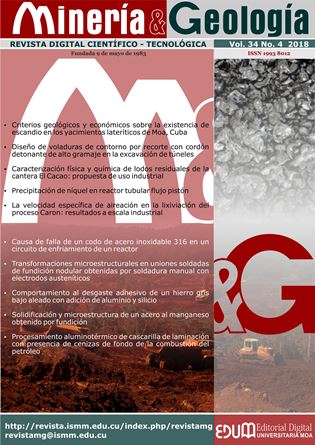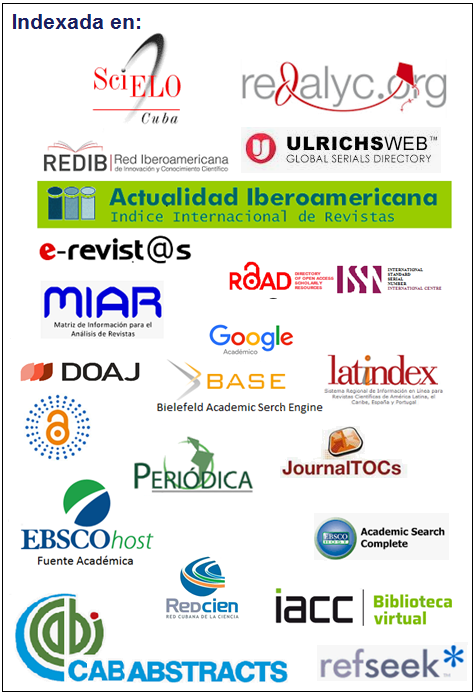Physical and chemical characterization of residual sludge from El Cacao quarry: proposal for industrial use
Keywords:
residual sludge, aggregate, El Cacao quarry, environmental protection.Abstract
Samples taken at the discharge of the conductive line to the sedimentation lagoon were characterized in terms of chemical composition, grading, reactivity, density, volumetric weight and humidity in order to propose possible destinations for sludge from "El Cacao" aggregate processing plant. It was determined that oxide calcium is the main constituent of these sludges; which make them perspective to be used as a raw material in the manufacture of lime with a particle diameter of 0.037 mm and a reactivity higher than 95%, as a neutralizer in the nickel industry and as a raw material for several applications in the construction industry, which would also contribute to mitigate the negative impact dumping this waste causes on the environment.Downloads
References
Amin, M. N.; Khan, K.; Saleem, M. U.; Khurram, N. y Niazi, M. U. K. 2017: Aging and curing temperature effects on compressive strength of mortar containing lime stone quarry dust and industrial granite sludge. Materials, 10(6): 1-22. DOI 10.3390/ma10060642.
Bengtsson, L. y Enell, M. 1986: Chemical analysis. En: B. Berglund (ed.). Handbook of Holocene palaeoecology and palaeohydrology. Chichester: John Wiley, p. 423–51.
Betancourt, D.; Martirena, F.; Day, R. y Diaz, Y. 2007: Influencia de la adición de carbonato de calcio en la eficiencia energética de la producción de ladrillos de cerámica roja. Revista Ingeniería de Construcción, 22(3): 187-196. DOI 10.4067/S0718-50732007000300005.
Breff, A.; Falcón, J. y Góngora, N. 2014: Evaluación de trabajo de un hidrociclón para la clasificación de la pulpa de cienos carbonatados. Tecnología Química, 34(2): 152-162. Disponible en: http://www.redalyc.org/articulo.oa?id=445543782008.
Caballero, Y. 2008: Caracterización de las pulpas de Cienos Carbonatados para su utilización como neutralizante. Informe inédito. Moa, Cuba: 28-31.
Campos, G. M. 2001: Nuevos datos acerca de la naturaleza y génesis de los sedimentos del yacimiento de Cieno Carbonatado en la bahía de Cayo Moa Grande. Informe inédito. Moa, Cuba: 8-15.
Casado, N. 1996: Edificios de alta calidad ambiental. Ibérica, Alta Tecnología. ISSN 0211-0776.
Crespo, R. 2015: Uso productivo de los finos residuales de la planta de tratamiento de áridos La Victoria en la producción de morteros de albañilería. Sexta Convención Cubana de Ciencias de la Tierra, GEOCIENCIAS´2015. La Habana: Red de Ciencias, p. 1-8.
Crespo, R. y Jiménez, R. 2012: Caracterización mineralógica y aplicaciones en la construcción de los lodos procedentes del lavado de áridos naturales. XXXIII Convención Panamericana de Ingenierías. La Habana: UPADI.
Cultrone, G.; De La Torre, M. J.; Sebastián, E. M.; Cazalla, O. y Rodríguez, C. 2000: Behavior of Brick Samples in Aggressive Environments. Water, Air & Soil Pollution, 119(1-4): 191–207. DOI 10.1023/A:1005142612180.
Dean, W. E. 1974: Determination of carbonate and organic matter in calcareous sediments and sedimentary rocks by loss on ignition; comparison with other methods. Journal of Sedimentary Research, 44(1): 242-248.
Díaz, Y.; Betancourt, D. y Martirena, F. 2011: Influencia de la finura de molido del carbonato de calcio en las propiedades físico mecánicas y de durabilidad de los ladrillos de cerámica roja. Revista Ingeniería de Construcción, 26(3): 269-283. DOI 10.4067/S0718-50732011000300002.
Galetakis, M.; Alevizos, G. y Leventakis, K. 2012: Evaluation of fine limestone quarry by-products, for the production of building elements - An experimental approach. Construction and Building Materials, 26(1): 122-130. DOI 10.1016/j.conbuildmat.2011.05.011.
González, B.; Alonso, J.; Rodas, M.; Barrenechea, J. F. y Luque, F. J. 2011: Microstructure and mineralogy of lightweight aggregates manufactured from mining and industrial wastes. Construction and Building Materials, 25(8): 3591-3602. DOI http://dx.doi.org/10.1016/j.conbuildmat.2011.03.053.
González, B.; Alonso, J.; Rodas, M.; Luque, F. J. y Barrenechea, J. F. 2010: Microstructure and mineralogy of lightweight aggregates produced from washing aggregate sludge, fly ash and used motor oil. Cement & Concrete Composites, 32(9): 694-707. DOI 10.1016/j.cemconcomp.2010.07.014.
González, B.; Alonso, J.; Rodríguez, L.; Pérez, A.; Fernández, M.; Tejado, J. J.; Corvinos, M. D. y Muro, C. 2016: Valorization of washing aggregate sludge and sewage sludge for lightweight aggregates production. Construction and Building Materials, 116: 252-262.
González, B.; Alonso, J. y Rodasb, M. 2009: Characterization of lightweight aggregates manufactured from washing aggregate sludge and fly ash. Resources, Conservation and Recycling, 53(10): 571-581. DOI 10.1016/j.resconrec.2009.04.008.
Hameed, M. S. y Sekar, A. S. S. 2009: Properties of green concrete containing quarry rock dust and marble sludge powder as fine aggregate. Journal of Engineering and Applied Sciences, 4(4): 83-89.
Hasimbuli, J. H. 2012: Estudio minero-ambiental de la cantera El Cacao. Ciencia & Futuro, 2(4): 49-58.
Hernández, C. M.; Savón, Y.; Almenares, R. S.; Montero, J. y Gómez, R. 2018: Diagnóstico ambiental de la Unidad Empresarial Básica procesadora de áridos Molino 200 mil en Holguín. Ciencia & Futuro, 8(2): 18-32.
Montserrat, M. M. 2004: Posibles aplicaciones de los residuos generados en el proceso de corte y elaboración de la piedra natural, para su utilización como materia prima en procesos industriales diversos. [en línea]. Consulta: 5 feb 2012. Disponible en: www.gencat.cat.
NC 1208, 2017: Cemento Ternario - Especificaciones. La Habana, Cuba.
NC 181, 2002: Áridos. Determinación del peso volumétrico. Método de ensayo. La Habana, Cuba.
NC 19, 1999: Geotecnia. Determinación del peso específico de los suelos. La Habana, Cuba.
NC 67, 2000. Geotecnia: Determinación del contenido de humedad de los suelos y rocas en el laboratorio. La Habana, Cuba.
NC 95, 2011: Cemento Portland. Especificaciones. La Habana, Cuba.
Rivera, P. S.; Asela, J. E.; Suárez, S. Y. y Zúñiga, A. C. 2007: Evaluación de calizas para la obtención de una cal para el suavizamiento de aguas subterráneas a nivel de laboratorio, utilizadas para consumo humano en el municipio de Villa del Rosario, departamento Norte de Santander. Respuestas, 12(1): 46-52.
Shenguelia, V. V. 1985: Mapa topográfico de escala 1:50,000 del I.C.G.C Hoja Baire 4976-IV. La Habana: ONRM.
Sort, X. y Alcañiz, J. M. 1996: Contribution of sewage sludge to erosion control in the rehabilitation of limestone quarries. Land Degradation and Development, 7(1): 69-76. DOI 10.1002/(SICI)1099-145X(199603)7:1<69::AID-LDR217>3.0.CO;2-2.
Tay, J. H. y Show, K. Y. 1997: Resource recovery of sludge as a building and construction material - A future trend in sludge management. Water Science and Technology, 36(11): 259-266. DOI 10.1016/S0273-1223(97)00692-6.
Vola, G.; Christiansen, T.; Sarandrea, L. y Ferri, V. 2013: Carbonate rocks characterization for the industrial lime manufacturing: worldwide case-studies. 14th Euroseminar on Microscopy Applied to Building Materials. Helsingør, Denmark: EMABM.
Published
How to Cite
Issue
Section
Copyright (c) 2018 Yaritza Cabrales-Clapé, Mayda Ulloa-Carcassés, Roger Samuel Almenares-Reyes

This work is licensed under a Creative Commons Attribution-NonCommercial 4.0 International License.
- Authors retain copyright and guaranteeing the right magazine to be the first publication of the work as licensed under a Creative Commons Attribution-NonCommercial that allows others to share the work with an acknowledgment of the work's authorship and initial publication in this journal.
- Authors may establish separate supplemental agreements for the exclusive distribution version of the work published in the journal (eg, place it in an institutional repository or publish it in a book), with an acknowledgment of its initial publication in this journal.
- Authors are allowed and recommended to disseminate their work through the Internet (e.g., in institutional telematic archives or on their websites) before and during the submission process, which can produce interesting exchanges and increase citations of the published work. (See The effect of open access)




